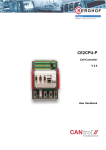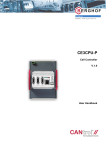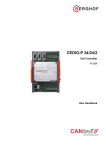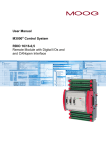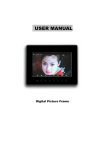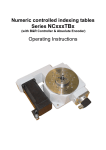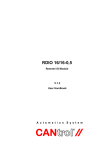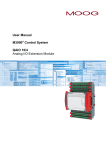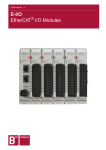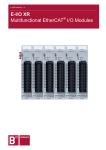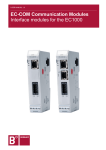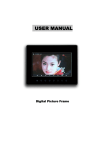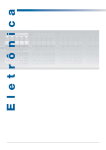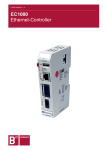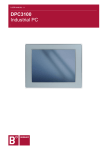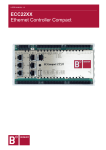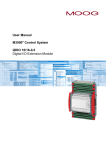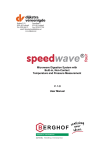Download CEDIO-P Module
Transcript
ZUNDEL Holding Enterprise CEDIO-P Cell Controller V.1.0 User Handbook Copyright © BERGHOF Automationstechnik GmbH Reproduction and duplication of this document and utilisation and communication of its content is prohibited, unless with our express permission. All rights reserved. Damages will be payable in case of infringement. Disclaimer The content of this publication was checked for compliance with the hardware and software described. However, discrepancies may arise, therefore no liability is assumed regarding complete compliance. The information in this document will be checked regularly and all necessary corrections will be included in subsequent editions. Suggestions for improvements are always welcome. Subject to technical changes. Trademark ® CANtrol // is a registered trademark of BERGHOFAutomationstechnik GmbH General Information on this Manual Content: This manual describes the CANtrol module CEDIO-P and its modifications. The product-related information contained herein was up to date at the time of publication of this manual. Completeness: This manual is complete only in conjunction with the user manual entitled ‘Introduction to CANtrol Automation System’ and the product-related hardware or software user manuals required for the particular application. Standards: The CANtrol automation system, its components and its use are based on International Standard IEC 61131 Parts 1 to 4 (EN 61131 Parts 1 to 3 and Supplementary Sheet 1). Supplementary Sheet 1 of EN 61131 (IEC 61131-4) entitled ‘User Guidelines’ is of particular importance for the user. Order numbers: Please see the relevant product overview in the ‘Introduction to CANtrol Automation System’ manual for a list of available products and their order numbers. Ident. No.: 2810420 You can reach us at: BERGHOF Automationstechnik GmbH Harretstr. 1 72800 Eningen / Germany Phone: +49 7121 / 894-0 Telefax: +49 7121 / 894-100 e-mail: [email protected] www.berghof-automation.de BERGHOFAutomationstechnik GmbH works in accordance with DIN EN ISO 9001 BERGHOF Automation CEDIO-P Update Version 1.0 Date 17.04.07 Subject First version CEDIO-P_HB_en_2D1042000ZD00.doc 3 CEDIO-P BERGHOF Automation blank page 4 CEDIO-P_HB_en_2D1042000ZD00.doc BERGHOF Automationstechnik CEDIO-P Contents 1. GENERAL INSTRUCTIONS....................................................................................... 7 1.1. Hazard Categories and Indications ......................................................................................................7 1.2. Qualified users .......................................................................................................................................7 1.3. Use as Prescribed ..................................................................................................................................8 2. CEDIO-P MODULE..................................................................................................... 9 2.1. Overview .................................................................................................................................................9 2.2. Technical Specifications .....................................................................................................................10 2.3. Block Circuit Diagram..........................................................................................................................12 2.4. Module View and Connection Assignment .......................................................................................13 2.5. Subassembly Operation ......................................................................................................................14 2.5.1. Commissioning ........................................................................................................................14 2.5.2. Function Selection, Displays, Diagnostics...............................................................................14 2.5.3. Serial Interfaces .......................................................................................................................15 2.5.4. Ethernet Interface ....................................................................................................................16 2.5.5. USB Interface...........................................................................................................................17 2.5.6. CAN Interfaces (Standard Design) ..........................................................................................18 3. DIGITAL INPUTS/OUTPUTS (HIGH SIDE-/LOW SIDE SWITCHING)..................... 19 3.1. Grouping of Inputs/Outputs ................................................................................................................19 3.1.1. Schematic Diagram of Input/Output Grouping (high side-/low side switching) .......................20 3.1.2. Without Grouping (high side-/low side switching)....................................................................21 3.2. Digital Inputs, high side switching .....................................................................................................22 3.2.1. Block diagram of input, high side switching.............................................................................22 3.3. Digital Inputs, low side switching.......................................................................................................23 3.3.1. Block diagram of input, low side switching ..............................................................................23 3.3.2. Digital Inputs Data (high side-/low side switching) ..................................................................24 3.4. Digital Outputs, high side switching ..................................................................................................26 3.4.1. Block diagram of output high side switching............................................................................26 3.5. Digital Outputs, low side switching....................................................................................................27 3.5.1. Block diagram of output low side switching .............................................................................27 3.5.2. Digital Outputs Data (high side-/low side switching)................................................................28 Overload Reaction of Digital Outputs (high side-/low side switching) .....................................29 4. ANNEX ..................................................................................................................... 31 4.1. Environmental Protection ...................................................................................................................31 4.1.1. Emission ..................................................................................................................................31 4.1.2. Disposal ...................................................................................................................................31 .doc CEDIO-P_HB_en_2D1042000ZD00.doc Seite 5 CEDIO-P BERGHOF Automation 4.2. Maintenance/Upkeep........................................................................................................................... 31 4.3. Repairs/Service.................................................................................................................................... 31 4.3.1. Warranty.................................................................................................................................. 31 4.4. Nameplate ............................................................................................................................................ 32 4.5. Addresses and Bibliography.............................................................................................................. 34 4.5.1. Addresses ............................................................................................................................... 34 4.5.2. Standards/Bibliography ........................................................................................................... 34 6 CEDIO-P_HB_en_2D1042000ZD00.doc BERGHOF Automation General Instructions 1. General Instructions 1.1. Hazard Categories and Indications The indications described below are used in connection with safety instructions you will need to observe for your own personal safety and the avoidance of damage to property. These instructions are emphasised by bordering and/or shading and a bold-printed indication, their meaning being as follows: Immediate danger Failure to observe the information indicated by this warning will result in death, serious injury or extensive property damage. Potential danger Failure to observe the information indicated by this warning may result in death, serious injury or extensive property damage. Danger Failure to observe the information indicated by this warning may result in injury or property damage. No hazard Information indicated in this manner provides additional notes concerning the product. 1.2. Qualified users Qualified users within the meaning of the safety instructions in this documentation are trained specialists who are authorised to commission, earth and mark equipment, systems and circuits in accordance with safety engineering standards and who as project planners and designers are familiar with the safety concepts of automation engineering. 2VF100054FE01.doc CEDIO-P_HB_en_2D1042000ZD00.doc 7 General Instructions 1.3. BERGHOF Automation Use as Prescribed This is a modular automation system based on the CANbus, intended for industrial control applications within the medium to high performance range. The automation system is designed for use within Overvoltage Category I (IEC 364-4-443) for the controlling and regulating of machinery and industrial processes in low-voltage installations in which the rated supply voltage does not exceed 1,000 VAC (50/60 Hz) or 1,500 VDC. Qualified project planning and design, proper transport, storage, installation, use and careful maintenance are essential to the flawless and safe operation of the automation system. The automation system may only be used within the scope of the data and applications specified in the present documentation and associated user manuals. The automation system is to be used only as follows: • as prescribed, • in technically flawless condition, • without arbitrary or unauthorised changes and • exclusively by qualified users The regulations of the German professional and trade associations, the German technical supervisory board (TÜV), the VDE (Association of German electricians) or other corresponding national bodies are to be observed. Safety-oriented (fail-safe) systems Particular measures are required in connection with the use of SPC in safetyoriented systems. If an SPC is to be used in a safety-oriented system, the user ought to seek the full advice of the SPC manufacturer in addition to observing any standards or guidelines on safety installations which may be available. As with any electronic control system, the failure of particular components may result in uncontrolled and/or unpredictable operation. All types of failure and the associated fuse systems are to be taken into account at system level. The advice of the SPC manufacturer should be sought if necessary. 8 CEDIO-P_HB_en_2D1042000ZD00.doc 2VF100054FE01.doc BERGHOF Automation CEDIO-P Module 2. CEDIO-P Module 2.1. Overview Order number The order/part no. is located on the nameplate of the individual modules for separate ordering. Function The Cell Controller is a real-time-capable control module with a broad spectrum of I/O and data interfaces. The module can be programmed in “C” or in accordance with IEC 61131-3 (CoDeSys 2.3). Ethernet An Ethernet interface operating at 10/100 MB/s is available. TCP/IP and UDP/IP protocols permit extremely flexible linkage to visualization software, higher-level control units or to the IT infrastructure. USB The USB host interface offers a widely used peripheral device interface. It can be used, for example, in conjunction with a USB stick to carry out an application update or data download. Please contact our Technical Support staff is driver support is not available for a specific USB device. CAN interfaces The Cell Controller is equipped with 2 standard CAN interfaces, both of which can be employed up to 1 MB/s. Serial interfaces The programming interface (RS232) can also be used by the application. Digital I/Os The module is equipped with 16 digital inputs and 16 digital inputs/outputs. E-bus expansion The Cell Controller’s I/O E/A level can be expanded by up to a maximum of 6 digital E-bus extensions. Overview of performance characteristics Standard delivery • Motorola PowerPC 5200 CPU / 400 MHz • Application program and data memory (RAM): 64 MB on board; 32 MB for the application • Application program memory (Flash): 16 MB on board; 8 MB for the application • Retain memory: 16 KB • 1 Ethernet 10/100 interface • 1 USB Host interface • 2 CAN interfaces • 1 serial RS232 interface for programming tools and application • 16 digital inputs • 16 digital, individually configurable inputs/outputs • I/O level locally expandable via internal E-bus up to 6 expansion modules (digital / analog) • Maintenance free due to lack of backup battery The standard control module delivery comprises: • 2VF100127FE00.doc CEDIO-P 16/16-0.5 control module CEDIO-P_HB_en_2D1042000ZD00.doc 9 CEDIO-P Module 2.2. BERGHOF Automation Technical Specifications Module data Versions CEDIO-P 16/16-0.5-1131 CEDIO-P 16/16-0.5 Part no. 201205000 201204000 Development environment CP1131 (as of V2.3) or CPC++ Dimensions, WxHxD [mm] 124 x 170 x 85.5 (in series dimensions W = 113/118.5) Weight approx. 700 g Installation Bearer rail, NS 35/7.5 EN 50022 Expansion With up to 6 E-bus expansion modules Operating temperature range 5° C to 50° C (non-condensing) convection cooling assured CPU PPC 5200 / 400 MHz Programming software IEC 61131-3 or high language “C” with real-time operating system Application memory Application program and data memory (RAM) 64 MB on board / 32 MB for the application Application program memory (Flash) 16 MB on board / 8 MB for the application Retain memory 16 KB EMI, protection class, insulation test, protection method Interference emission EN 50081-2, industrial areas Interference resistance EN 50082-2, industrial areas Protection class III Insulation resistance EN 61131-2; DC 500 V test voltage Protection method IP 20 Supply voltage, current consumption Power supply, module electronics (connection voltage) SELV DC +24 V < 0.4 A (EN 61131-2) Power supply, digital I/Os DC +24 V (EN 61131-2) divided into 3 groups Power consumption At Ue= DC +24 V in neutral, a max. of 500 mA, Fuses, depending on the I/O loads: max. 10 A Supply voltage polarity reversal protection Yes Potential isolation Yes Digital inputs/outputs (DIO) Number of inputs 16 Number of inputs/outputs 16 Output current 0.5 A Short circuit protection Yes Potential isolation Yes Connection technique Standing 3-wire front wiring with terminal strips for screw-on, crimping, terminals. 10 CEDIO-P_HB_en_2D1042000ZD00.doc 2VF100127FE00.doc BERGHOF Automation CEDIO-P Module Ethernet interface Number / type of interfaces 1 Ethernet 10/100 interface Protocols TCP/IP and UDP/IP Connection technique RJ45 (ETH, X10) USB interface Number / type of interfaces 1 USB Host interface, V1.1 (X30) Serial data interfaces Number / type of interfaces 1 RS232 (X9) for programming / application CAN interfaces Number / type of interfaces 2 CAN ISO11898 CAN channel 0 (X7/X8) on the cover CAN channel 1 on the E-bus connector Operating / display elements LEDs 5 status LEDs; 1 status LED per digital input/output (DIO) (not for the special timer inputs/outputs) Operating mode selector switch Yes, on the cover (S0) Programming Via Ethernet or RS232 port (X9) 2VF100127FE00.doc CEDIO-P_HB_en_2D1042000ZD00.doc 11 CEDIO-P Module 2.3. BERGHOF Automation Block Circuit Diagram X10 X9 X8 X7 SIO SIO Transceiver CAN 0 CAN Transceiver UCST S0 + Status-LED E-Bus E-Bus Interface CAN0 CAN1 CPU RAM SIO DC Serial EEPROM L2 4x IN/OUT In/Out 1-4 L1 8x IN In 5-12 M1 CAN Transceiver +5V Mi +8V SMPN DC CAN1 UCCPU Serial EEPROM E-Bus + CAN 1 IN E-Bus Interface L4 OUT OUT IN IN M1 4x IN/OUT In/Out 17-20 M6 IN L6 8x IN In 21-28 IN M6 M1 L5 L3 OUT OUT IN IN M1 M6 E-Bus + CAN 1 OUT 4x IN/OUT In/Out 29-32 U QDIO 16/16-0,5 I/O 4x IN/OUT In/Out 13-16 Hinweis: Links vom Modul dürfen keine C-, Q- oder R-Module angereiht werden. E-Bus IN und CAN1 IN sind nicht verfügbar. Note: On the left side of the module C-, Q- or R-modules mustn't end-to-end.E-bus IN and CAN1 IN are not available. 2VF100299DG00.cdr 12 CEDIO-P_HB_en_2D1042000ZD00.doc 2VF100127FE00.doc BERGHOF Automation Module View and Connection Assignment +24 V 2.4. CEDIO-P Module 1 M1 2 3 4 5 6 7 8 9 10 11 12 13 14 15 16 17 18 33 35 36 X1 31 32 34 X2 +24 V 30 I/O16 29 I/O15 28 I/O14 27 I/O13 26 IN7 25 IN6 24 IN5 23 I/O4 22 I/O3 21 I/O2 20 I/O1 19 +24 V +24 V= 37 38 39 40 41 42 43 44 45 46 47 48 49 50 51 52 53 54 3 4 5 6 7 8 9 10 11 12 13 14 15 16 17 18 X1 21 22 23 24 25 26 27 28 29 30 31 32 33 34 35 36 X2 39 40 41 42 43 44 45 46 47 48 49 51 52 53 54 X3 X3 M1 L1+ / +24 V = module electr. IN5 - IN12 1 2 19 20 37 38 IN/OUT I/O1 I/O2 I/O3 50 IN I/O4 IN5 IN6 IN7 7 8 IN8 IN/OUT IN9 IN10 IN11 IN12 11 12 L3+ / +24 V = I/O13 - I/O16 I/O13 I/O14 I/O15 I/O16 13 14 15 16 17 31 32 33 34 35 I/O Status LEDs L1+ M1 1 2 X1 3 4 5 6 9 10 X2 19 20 21 22 23 24 25 26 27 28 29 30 X3 37 L2+ 38 I/O1 39 I/O2 40 I/O3 41 I/O4 42 IN5 43 IN6 44 IN7 45 IN8 46 IN9 47 IN10 48 IN11 49 50 51 53 52 IN12 I/O13 I/O14 I/O15 I/O16 18 Printable area for I/O labelling 36 54 L3+ Status LEDs 2 3 1 Links vom Modul dürfen keine C-, Q- oder R-Module angereiht werden. E-Bus IN und CAN1 IN sind nicht verfügbar. green 1 2 3 4 5 E-Bus OUT S0 green Power CAN ON active green 4 5 red red application specific CAN1 OUT On the left side of the module C-, Q- or R-modules mustn't end-to-end. E-bus IN and CAN1 IN are not available. Nameplate USB Host X4 L4+ I/O17 I/O18 I/O19 I/O20 57 58 55 59 56 X5 73 X6 IN21 60 IN22 61 IN23 62 IN24 63 IN25 64 IN26 65 IN27 66 IN28 67 74 75 76 77 78 79 80 81 82 83 84 85 I/O29 I/O30 I/O31 I/O32 68 69 71 70 86 87 88 89 90 91 92 93 94 95 96 97 98 99 100 101 102 103 104 105 106 107 108 L6+ M6 IN27 IN28 I/O29 I/O30 I/O31 I/O32 Betriebswahlschalter / operation mode selector switch L5+ 72 Printable area for I/O labelling I/O Status LEDs I/O17 L4+ / +24 V = I/O17 - I/O20 L6+ / +24 V = IN21 - IN28 I/O18 I/O19 I/O20 IN21 IN22 IN23 IN/OUT 55 56 57 IN24 IN25 IN26 IN 58 59 60 61 62 63 L5+ / +24 V = I/O29 - I/O32 IN/OUT 64 82 65 83 66 67 84 85 68 86 69 87 70 88 71 89 72 X4 OUT L M 73 74 75 76 77 78 79 80 81 90 X5 91 92 93 94 95 96 97 98 99 100 101 102 103 104 105 106 107 108 X6 IN L M IN21 IN22 IN23 59 60 61 62 +24 V I/O20 58 I/O32 I/O19 57 I/O31 I/O18 56 I/O30 I/O17 55 I/O29 +24 V M6 65 66 67 68 69 70 71 72 X4 83 84 85 86 87 88 89 90 X5 99 100 101 102 103 104 105 106 107 108 X6 63 64 +24 V= 74 75 76 77 78 79 80 +24 V 73 91 81 82 M6 92 93 94 95 96 97 98 2VF100300DG00.cdr 2VF100127FE00.doc CEDIO-P_HB_en_2D1042000ZD00.doc 13 CEDIO-P Module 2.5. BERGHOF Automation Subassembly Operation Do not connect, apply, disconnect, or touch connectors during operation! This could result in destruction or incorrect function. Prior to any work on the modules, switch all feeds off including those from connected peripheral devices, separately powered actuators, programming devices, etc. 2.5.1. Commissioning Before applying the supply voltage perform one last check of all connections to make sure they are wired correctly and have the correct polarity. Switch the supply voltage on. For more information, please refer to the associated software documentation. 2.5.2. Function Selection, Displays, Diagnostics I/O status Each input and output is assigned a yellow LED which indicates the logical state of the associated input or output. I/O status LED state Operating mode selector switch 14 Logical state Input LED Yellow ON 1 (HIGH, activated) Input LED Yellow OFF 0 (LOW) Output LED Yellow ON 1 (HIGH, activated) Output LED Yellow OFF 0 (LOW) Used to switch between operating modes and to restart the module. This function is software dependent. Switch position CP1131 CPC++ RUN (R) CP1131 program in the RUN state; can be changed with the programming device. Freely programmable STOP (S) CP1131 program in the STOP state Freely programmable RESET (F) CP1131 program (in RAM) and the RETAIN variables will be deleted. Freely programmable CEDIO-P_HB_en_2D1042000ZD00.doc 2VF100127FE00.doc BERGHOF Automation Operating status CEDIO-P Module Five operating status LEDs provide information concerning the current state of the power supply, the module mode and other functions. The status LEDs are also used to display error messages. Operating status LED state Logical state 1 L1+ (green) ON = 2 CAN status 2 (green) ON = Correct supply voltage to the module electronics CAN 0 send active Operating status, CPC++ LEDs 3 to 5 can be controlled by the application software. Operating status, CP1131 2.5.3. Status3 (green) Status4 (red) Status5 (red) Either Either On At least one variable is force controlled (FORCE). On Off Either Application program in the RUN state. Off On Either Application program in the STOP state. Off Flashing Either Application program in the ERROR STOP state. Flashing On Either Application program in the breakpoint STOP state. Description Serial Interfaces The module is equipped with a serial interface (RS232) which can be used for programming or for the application. X9: RS232 programming interface Pin 2VF100127FE00.doc Signal Description 1 Reserved Do not connect 2 RXD Received data 3 TXD Transmitted data 4 Reserved Do not connect 5 GND Signal ground 6 Reserved Do not connect 7 Reserved Do not connect 8 Reserved Do not connect CEDIO-P_HB_en_2D1042000ZD00.doc 15 CEDIO-P Module 2.5.4. BERGHOF Automation Ethernet Interface An Ethernet interface operating at 10/100 MB/s is available. TCP/IP and UDP/IP protocols permit extremely flexible linkage to visualization software, higher-level control units or to the IT infrastructure. PC / HUB / CANtrol Verbindungskabel 10BaseT mit Stecker RJ45 Interconnecting cable 10BaseT with plug RJ45 E TH E R N E T X 10 Kabel Kategorie 5 (KAT.5) / Cable Categorie 5 (CAT.5) Aderquerschnitt / core cross-section min. 0,22 mm² 1 TD+ Stecker / plug 2 TD- contact view Stecker / plug TD+ 1 contact view TD- 2 1 8 1 8 RD+ 3 RD- 6 3 RD+ 6 RD- CANtrol / Ethernet Patch-Kabel 10BaseT mit Stecker RJ45 Interconnecting cable 10BaseT with plug RJ45 E TH E R N E T X 10 Kabel Kategorie 5 (KAT.5) / Cable Categorie 5 (CAT.5) Aderquerschnitt / core cross-section min. 0,22 mm² 1 TD+ Stecker / plug 2 TD- contact view Stecker / plug TD+ 1 contact view TD- 2 1 8 crossing pin 1 / 3 crossing pin 2 / 6 twisted pair 8 1 3 RD+ 6 RD- RD+ 3 RD- 6 2VF100238DG00.cdr X10: 16 Ethernet pin assignment Pin Signal Description 1 TD+ 2 TD- 3 RD+ 4 NC Do not connect 5 NC Do not connect 6 RD- 7 NC Do not connect 8 NC Do not connect CEDIO-P_HB_en_2D1042000ZD00.doc 2VF100127FE00.doc BERGHOF Automation 2.5.5. CEDIO-P Module USB Interface Devices with USB connectors (x30) can be connected to the USB port (Rev. 1.1). This is a USB host interface which delivers up to 500 mA of current at +5V. The subassembly power pack also supplies the electronics on the E-bus expansion modules. If more than 100 mA are required at the USB interface, the maximum number of E-bus subscribers is reduced. Pin assignment X30 USB B1 VCC B2 D- B3 D+ B4 GND The only USB devices classes which can be employed for CoDeSys users are USB sticks. A mouse can only be employed at the Linux level. The following points must be taken into consideration when USB sticks are employed: A USB stick may only be pulled during operation if all file operations have been completed, otherwise the USB stick may become unusable! If programs still have files open, the directory will no longer be able to be removed once the USB stick has been pulled. In this situation file or directory operations will result in blockages because information is to be read from a device that is no longer available in the system. Therefore, always make sure that no program still has open files in the USB stick before pulling the stick. • USB memory sticks can be inserted and pulled during operation. The inserted device is automatically detected and mounted in the /media/usbX directory. When the USB stick is pulled, the associated /media/usbX directory automatically “disappears” provided no program is currently accessing it (see above). • Either the first partition or, if there are no partitions, the entire memory will be mounted on the memory stick, in other words, the associated directory appears automatically. • The first stick is mounted under /media/usb0, the second under /media/usb1, and so on. A maximum of 8 sticks may be inserted simultaneously (/media/usb[0-7]). If a new (or previously inserted, then pulled) stick is inserted it will be placed on the directory with the lowest number. Connecting a USB hub allows multiple sticks to be operated at a given USB interface. Care must be taken that no USB devices are still inserted in the hub when the hub is itself inserted or pulled. The mechanical structure of the USB port is designed for a maximum insertion cycles. 2VF100127FE00.doc CEDIO-P_HB_en_2D1042000ZD00.doc 17 CEDIO-P Module 2.5.6. BERGHOF Automation CAN Interfaces (Standard Design) The CPU module is equipped with a total of 2 CAN interfaces with CAN bus voltage levels in accordance with ISO/DIS11898. The standard CAN interfaces correspond to the description contained in the manual, “Introduction to CANtrol Automation Systems”. CAN channel 0 X7/X8 on the front face Aside from its duty as an application-specific communications interface, channel 0 also serves as the programming interface. The max. baud rate is 1 MB/s and can be adjusted by software. CAN channel 1 The second CAN interface (channel 1) is located on the E-bus plug-in connector on the side of the unit. This interface is equipped with a CAN terminal resistor. The max. baud rate is 1 MB/s and can be adjusted by software. CAN Channel 0 CAN Contr. CAN Channel 0 E-Bus CAN Channel 1 + intern. E-Bus CAN1 X7 CAN CAN Channel 0 CPU X8 CAN X9 SIO CAN Channel 1 CAN Contr. 2VF100298DG00.cdr X7 / X8: Pin assignment Pin Signal Description 1 Reserved Do not connect 2 CAN_L CAN Low Signal 3 CAN_GND Signal ground 4 Reserved Do not connect 5 (CAN_SHLD) Optional CAN shield 6 (GND) Optional Signal ground 7 CAN_H CAN High Signal 8 Reserved Do not connect 9 (CAN_V+) Optional external driver supply For more information about connecting the CAN interface, please refer to the manual, “Introduction to CANtrol Automation Systems”. 18 CEDIO-P_HB_en_2D1042000ZD00.doc 2VF100127FE00.doc BERGHOF Automation 3. Digital I/O 16/16-0,5 Digital Inputs/Outputs (high side-/low side switching) Outputs may also be connected to inputs without additional external load. 3.1. Grouping of Inputs/Outputs The grouping facility permits formation of groups, separate power circuits, emergency off circuits, etc. as and when required. Inputs/outputs can be supplied in groups as • 2 input groups and • 4 output / input groups The modular electronic circuit for C modules is supplied together with input group 2 (Group 2) over connection terminals 1 (L1+) and 2 (M1). The modular electronic circuit must be supplied with power in any cases, otherwise the modules will be inoperable. Supply must be provided directly (unswitched) from the supply unit. Inputs Inputs (sensors) must be supplied directly from the supply unit. Do not conduct the sensor supply through switched circuits. Outputs Output groups may be supplied through upstream switch elements (emergency off, manual switches, etc.). Feedback could destroy the module and/or the sensors! Otherwise, when group power supply is disconnected, connected sensors could produce a feedback over the output transistors. Always make sure the sensors are each supplied from the same power source as the module’s associated I/O group. 2VF100004FE04.doc CEDIO-P_HB_en_2D1042000ZD00.doc 19 Digital I/O 16/16-0,5 3.1.1. BERGHOF Automation Schematic Diagram of Input/Output Grouping (high side-/low side switching) 2VF100007DG00.cdr 20 CEDIO-P_HB_en_2D1042000ZD00.doc 2VF100004FE04.doc BERGHOF Automation 3.1.2. Digital I/O 16/16-0,5 Without Grouping (high side-/low side switching) 2VF100008DG01.cdr 2VF100004FE04.doc CEDIO-P_HB_en_2D1042000ZD00.doc 21 Digital I/O 16/16-0,5 3.2. BERGHOF Automation Digital Inputs, high side switching The digital inputs are high side switching type 1 inputs for 3-conductor sensors. They are designed for input voltages of 24 V nominal. The inputs are transmitted cyclically to the CPU. An open input is interpreted as static 0 (LOW). Pulse recognition and interference suppression Inputs are read cyclically. Pulses < 100 μs are hardware suppressed. The sampling interval can be parameterised by software. The shortest possible sampling interval is 250 μs. If pulses are to be detected reliably they must be longer than the sampling interval stipulated by software. Multiple sampling can be programmed in order to suppress spurious pulses. Sampling interval and multiple sampling (filtering) can be activated in groups of 32 inputs each. This function is available only for C applications at present. Using IEC 61131-3 the filter is permanently set to 250 µs. Operating status 3.2.1. The status of each input is indicated by a yellow operating status LED on the front panel of the module. The LEDs are spatially assigned to the supply terminals. An LED lights when its associated input is activated (logical 1 / HIGH). Block diagram of input, high side switching 2VF100009DG01.cdr 22 CEDIO-P_HB_en_2D1042000ZD00.doc 2VF100004FE04.doc BERGHOF Automation 3.3. Digital I/O 16/16-0,5 Digital Inputs, low side switching The digital inputs are low side switching type 1 inputs for 3-conductor sensors. They are designed for input voltages of 24 V nominal. The inputs are transmitted cyclically to the CPU. An open input is interpreted as static 0 (LOW). Pulse recognition and interference suppression Inputs are read cyclically. Pulses < 100 μs are hardware suppressed. The sampling interval can be parameterised by software. The shortest possible sampling interval is 250 μs. If pulses are to be detected reliably they must be longer than the sampling interval stipulated by software. Multiple sampling can be programmed in order to suppress spurious pulses. Sampling interval and multiple sampling (filtering) can be activated in groups of 32 inputs each. This function is available only for C applications at present. Using IEC 61131-3 the filter is permanently set to 250 µs. Operating status 3.3.1. The status of each input is indicated by a yellow operating status LED on the front panel of the module. The LEDs are spatially assigned to the supply terminals. An LED lights when its associated input is activated (logical 0 / LOW). Block diagram of input, low side switching 2VF100085DG00.cdr 2VF100004FE04.doc CEDIO-P_HB_en_2D1042000ZD00.doc 23 Digital I/O 16/16-0,5 3.3.2. BERGHOF Automation Digital Inputs Data (high side-/low side switching) Module data Number of inputs 16 (max. 32) Line lengths: in switchgear cabinet dedicated l.v. wiring 24 Allow for voltage drop when choosing conductor cross-section, otherwise no restrictions in practice. Observe all relevant local regulations and the requirements of EN 61131-3. Please consult manufacturer regarding lightning hazard Rated load voltage L+ Reverse voltage protection 24 VDC (SELV) yes Electrical isolation yes (optical isolator) in groups Status display yes, yellow LED for each input Alarms definable according to software Input delay parameterisable by software Input capacitance < 10 nF CEDIO-P_HB_en_2D1042000ZD00.doc 2VF100004FE04.doc BERGHOF Automation Digital I/O 16/16-0,5 Digital-input operating areas (high side-/low side switching) 2VF100010DG00.cdr 2VF100004FE04.doc CEDIO-P_HB_en_2D1042000ZD00.doc 25 Digital I/O 16/16-0,5 3.4. BERGHOF Automation Digital Outputs, high side switching The module can be destroyed by overvoltages > 32 V and / or feedback. Risk of fire! Each digital output is also usable as an input. See description under ‘Digital Inputs’ if using as input. Outputs The outputs are of high side switching 24 volt type (two-conductor). Maximum output current per output is 500 mA. The outputs have a common earth (GND) when operating in groups. Power is supplied separately from the supply for the modular electronic circuit (see ‘Connection Assignment’). The outputs switch automatically to ‘0’ (LOW) if there is no available data link to the CPU or if the module’s internal supply is insufficient. Protected output All outputs are protected by an incorporated current-limiting circuit and a thermal overload protection circuit. If overloaded, the affected output switches off. The output can be re-activated by program on elimination of the overload and thermal cooling. A high-speed de-excitation feature having a terminal voltage of 50 V, related to L+, protects all outputs against induced voltage peaks under inductive loads. The overload protection of non-involved outputs may also respond prematurely if feedback or high-speed de-excitation give rise to thermal loads. Operating status The status of each output is indicated by a yellow operating status LED on the front panel of the module. The LEDs are spatially assigned to the supply terminals. A LED lights when its associated output is activated, logical ‘1’ (HIGH). 3.4.1. Block diagram of output high side switching 2VF100011DG01.cdr 26 CEDIO-P_HB_en_2D1042000ZD00.doc 2VF100004FE04.doc BERGHOF Automation 3.5. Digital I/O 16/16-0,5 Digital Outputs, low side switching The module can be destroyed by overvoltages > 32 V and / or feedback. Risk of fire! Each digital output is also usable as an input. See description under ‘Digital Inputs’ if using as input. Outputs The outputs are of low side switching 24 volt type (two-conductor). Maximum output current per output is 500 mA. The outputs have a common earth (GND) when operating in groups. Power is supplied separately from the supply for the modular electronic circuit (see ‘Connection Assignment’). The outputs switch automatically to ‘1’ (HIGH) if there is no available data link to the CPU or if the module’s internal supply is insufficient. Protected output All outputs are protected by an incorporated current-limiting circuit and a thermal overload protection circuit. If overloaded, the affected output switches off. The output can be re-activated by program on elimination of the overload and thermal cooling. The overload protection of non-involved outputs may also respond prematurely if feedback give rise to thermal loads. Operating status The status of each output is indicated by a yellow operating status LED on the front panel of the module. The LEDs are spatially assigned to the supply terminals. A LED lights when its associated output is activated, logical ‘0’ (LOW). 3.5.1. Block diagram of output low side switching 2VF100086DG00.cdr 2VF100004FE04.doc CEDIO-P_HB_en_2D1042000ZD00.doc 27 Digital I/O 16/16-0,5 3.5.2. BERGHOF Automation Digital Outputs Data (high side-/low side switching) Module data Number of outputs Type of outputs Suppressor circuit for inductive loads Power loss due to de-excitation 16 semiconductor outputs in 4 groups semiconductor, non-holding high-speed de-excitation 50 V terminal voltage (typical) to + 24 V max. 0.5 watts per output max. 4 watts per module Status display yes, yellow LED for each output Diagnostic function yes, switching state can be read back at pin Load connection Total loading (100%) 8 A (16 x 0,5 A) Overload protection yes, in event of thermal overload Responding of thermal overload protection may influence adjoining outputs Short-circuit protection 1) response threshold yes, electronic current-limiting feature, min. 0.5 A, typically 0.9 A 1) Current is limited electronically. Responding of the short-circuit protection feature produces thermal overload and trips the thermal overload protection circuit.. Output delay for ‘0’ to ‘1’ for ‘1’ to ‘0’ max. 0,5 ms max. 0,5 ms Output capacitance < 20 nF Rated voltage Voltage drop (at rated current) +24 VDC < 0,5 V Rated current for ‘1’ signal Leakage current for ‘0’ signal Total current of all outputs Total current per group 0,5 A max. 0,1 mA max. 8 A (16 x 0,5) max. 2 A (4 x 0,5) (horizontal mounting on vertical mounting plate) Lamp load (+24 VDC) max. 6 watts Connection of two outputs in parallel to provide logic operation to increase performance allowed not allowed Insulation resistance 28 Rated voltage 0 V <Ue <50 V Test voltage up to 2,000 m altitude 500 VDC CEDIO-P_HB_en_2D1042000ZD00.doc 2VF100004FE04.doc BERGHOF Automation Digital I/O 16/16-0,5 Overload Reaction of Digital Outputs (high side-/low side switching) 2VF100021DG00.cdr It is not possible to know for certain within the current limit scatter band whether the response will be to disconnect or to return to the working range. As a result, this state should be avoided! The output is ready for operation by elimination of the overload and thermal cooling. 2VF100004FE04.doc CEDIO-P_HB_en_2D1042000ZD00.doc 29 Digital I/O 16/16-0,5 BERGHOF Automation blank page 30 CEDIO-P_HB_en_2D1042000ZD00.doc 2VF100004FE04.doc BERGHOF Automation Annex 4. Annex 4.1. Environmental Protection 4.1.1. Emission When used correctly, our modules do not produce any harmful emissions. 4.1.2. Disposal At the end of their service life, modules may be returned to the manufacturer against payment of an all-inclusive charge to cover costs. The manufacturer will then arrange for the modules to be recycled. 4.2. Maintenance/Upkeep Do not insert, apply, detach or touch connections while in operation – risk of destruction or malfunction. Disconnect all incoming power supplies before working on our modules; this also applies to connected peripheral equipment such as externally powered sensors, programming devices, etc. All ventilation openings must always be kept free of any obstruction. The modules are maintenance-free when used correctly. Clean only with a dry, non-fluffing cloth. Do not use detergents. 4.3. Repairs/Service Repair work may only be carried out by the manufacturer or its authorised service engineers. 4.3.1. Warranty Sold under statutory warranty conditions. Warranty lapses in the event of unauthorised attempts to repair the equipment and/or product, or in the event of any other form of intervention. 2VF100055FE01.doc CEDIO-P_HB_en_2D1042000ZD00.doc 31 Annex 4.4. BERGHOF Automation Nameplate 2VF100080DG01.cdr 32 CEDIO-P_HB_en_2D1042000ZD00.doc 2VF100055FE01.doc BERGHOF Automation Annex 1 Barcode same as identification number. 2 Module type plain-text name of module. 3 Identification no. module's identification number. 4 Model/order no. You only need to give this number when ordering a module. The module will be supplied in its current hardware and software version. 5 Version defines the design-level of the module as supplied ex-works. 6 Supply voltage 7 Date internal code. 8 CE mark The ‘Version’ (supply version) panel specifies the design-level of the module as supplied ex-works. When replacing a module, users, with the CNW (CANtrol Node Wizard) tool, can read off the current software version of the newly supplied module, and then reload their 'own' software version for a particular project if necessary. With the latter in mind, before the download you should always keep a record of the existing software levels in your project documentation (software version, node IDs, baud rate, etc.). 2VF100055FE01.doc CEDIO-P_HB_en_2D1042000ZD00.doc 33 Annex BERGHOF Automation 4.5. Addresses and Bibliography 4.5.1. Addresses CiA 'CAN in Automation', international manufacturers and users organisation for CAN users in the field of automation: CiA - CAN in Automation e.V. Am Weichselgarten 26 D-91058 Erlangen /Germany e-mail: [email protected] http://www.can-cia.de DIN-EN Standards Beuth Verlag GmbH or 10772 Berlin VDE-Verlag GmbH 10625 Berlin IEC Standards VDE Verlag GmbH 10625 Berlin Internet search http://www.iec.ch/ 4.5.2. or Standards/Bibliography IEC61131-1/EN61131-1 Programmable controllers Part 1: General information IEC61131-2/EN61131-2 Programmable controllers Part 2: Equipment requirements and tests IEC61131-3/EN61131-3 Programmable controllers Part 3: Programming languages IEC61131-4/EN61131Bl1 Programmable logic controllers Supplementary Sheet 1: User guidelines EN 50081 Parts 1+2 German EMC Act: Emitted interference EN 50082 Parts 1+2 German EMC Act: Noise immunity ISO/DIS 11898 Draft International Standard: Road vehicles - Interchange of digital information Controller Area Network (CAN) for high-speed communication EN 954-1 Safety of machinery: Safety-related parts of control systems (Part 1) Bibliography A variety of specialist publications on the CANbus is available from specialist bookshops, or can be obtained through the CiA users' organisation. Our Technical Support team will be glad to provide other literature references on request. 34 CEDIO-P_HB_en_2D1042000ZD00.doc 2VF100055FE01.doc


































